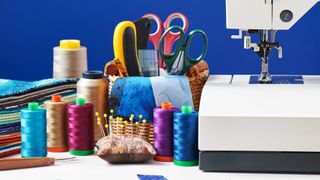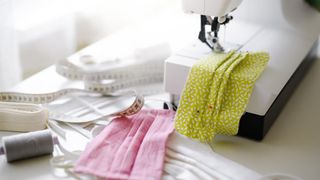The best sewing machines can unlock a whole world of creative possibilities. Or make a great practical addition to your home, helping you mend an item of clothing in a flash. Along with the best die cutting machines, sewing machines are excellent for dedicated craft pursuits, but it can be hard to work out exactly what you need from them if you’re a beginner, or if you’re looking to upgrade.
Computerized sewing machines have become increasingly popular in recent years, due to their practical features which make stitching easier. But mechanical sewing machines still have their perks, especially for those who grew up using them. So, even though the improvements of computerized models are impressive, it’s worth bearing in mind how adventurous you are with your technology before we dive into the differences between the machines. If you don’t tend to get on with new technology too well, then it may be a simple choice of sticking with a more traditional mechanical model.
Computerized vs Mechanical: Features
Computerized models steal the show when it comes to the widest range of intricate features that you could need in a sewing machine. Built-in stitch patterns are the big draw of computerized machines, with some models offering over 200 different options. More choice with stitches is great for branching out in your sewing pursuits, such as incorporating letters or numbers into your stitching. But according to the Sewing Machine Savvy blog, 'even the most experienced sewists would struggle to truly make the most of hundreds of stitch patterns, especially as some are decorative rather than practical and wouldn’t suit working on large areas of fabric'. Computerized machines with fewer stitching options will still serve you well and probably have enough variation to keep you experimenting.
Mechanical machines usually have a fraction of the number of stitch styles that computerized models do. This isn’t necessarily a negative thing. If you’re overwhelmed by the idea of so many stitches or you know you’ll only use a handful of them, then mechanical machines may be better for you. Mechanical sewing machines tend to be sturdy and well built, meaning they can handle any type of fabric, as well as stand the test of time. If you grew up around mechanical sewing machines, or have previously used one, then you might be more comfortable using their manual controls too, such as foot pedals.
The automatic features of computerized machines certainly go a long way to make your life easier. These include sewing lights, automatic needle threaders and cutters, and automatic tension adjusters. Like stitch patterns, lots of machines also have built-in buttonhole styles, so you have even more choice when it comes to your designs. These are all great additions to have, but some may find them a world of complication away from the simplicity of traditional machines.

Computerized vs Mechanical: Versatility
Meeting your needs when it comes to selecting a sewing machine is all about what you want to create. If you only want to do basic sewing procedures, or at least, start with them, then you could be swayed to either a mechanical or a computerized machine. For beginners, a computerized machine may require less work with manual activities such as threading and cutting and therefore make a great choice. On the other hand, mechanical machines may be simpler to operate for a beginner, especially if you’re less inclined to technology, and have all you need to perform basic stitches.
For those more experienced or adventurous, computerized machines definitely pack a lot in with their features. If you want to do embroidery or quilting, then their versatility and ability to work on multi-layer fabrics will probably make them more attractive than mechanical machines. What’s more, lots of the computerized machines come with instructional videos or manuals, meaning you can follow someone using your machine on screen and discover lots of new techniques and sewing styles this way.
Computerized vs Mechanical: Cost
It’s no surprise that computerized sewing machines tend to cost more than traditional models given their extensive features and automatic systems. High-end machines can cost over $1,000 and tend to work at an extremely fast stitch per minute rate, which is great for professional sewists. For those not looking to splash quite so much cash, there are affordable options for both types of machines, with even computerized models available for under $200. Beginners might want to start with a less expensive manual model before assessing whether they would use the features of a computerized model, but equally, you could jump in with a computerized model at not too much of a cost.
Once you know what you want from your machine, establish if it’s more effective to buy attachments for specific types of sewing or buy a machine with those functions built-in, like embroidery. Extra sewing feet are another thing to consider in your budget, as certain feet may come with your machine or need to be purchased afterward.

Computerized vs Mechanical: Size & appearance
Sewing machines can be bulky appliances, especially mechanical ones. If you’re looking for a more portable choice, then a smaller computerized option is probably easier to take around with you, with some machines sold with carry cases. When it comes to aesthetics, the main distinguishing feature between models is whether they display all of their possible stitch patterns on the machine itself, or whether they are stashed away within a fold-out card. If you’re a beginner, you will most certainly find it easier to have the stitches you need in front of you, but that might mean compromising some aesthetic value.
Should you buy a computerized or a mechanical sewing machine?
In many ways, computerized models may seem like the obvious choice when it comes to sewing machines, given the number of stitch patterns and features available. But a more complicated setup is not to everyone’s needs or budgets, so consider how much use you’ll be getting out of your machine for your money. Plus, there’s always room to upgrade your sewing machine once you’ve established which type of model best suits you, or once you’ve gained more experience, so starting out with a more basic computerized or mechanical model might just be for the best. Or if you have more experience, factoring in exactly which features and attachments you want before spending lots of cash on an upgrade is essential.

